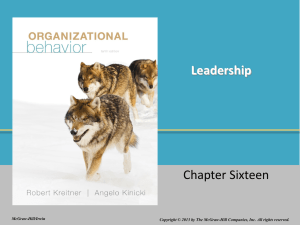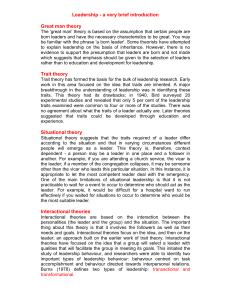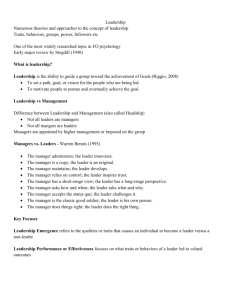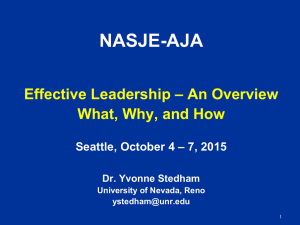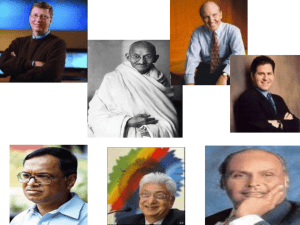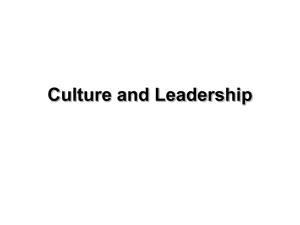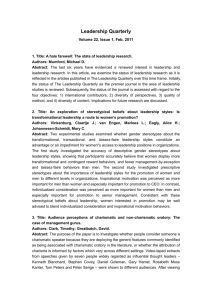Learning about Leadership. Module 1 Module 1
advertisement
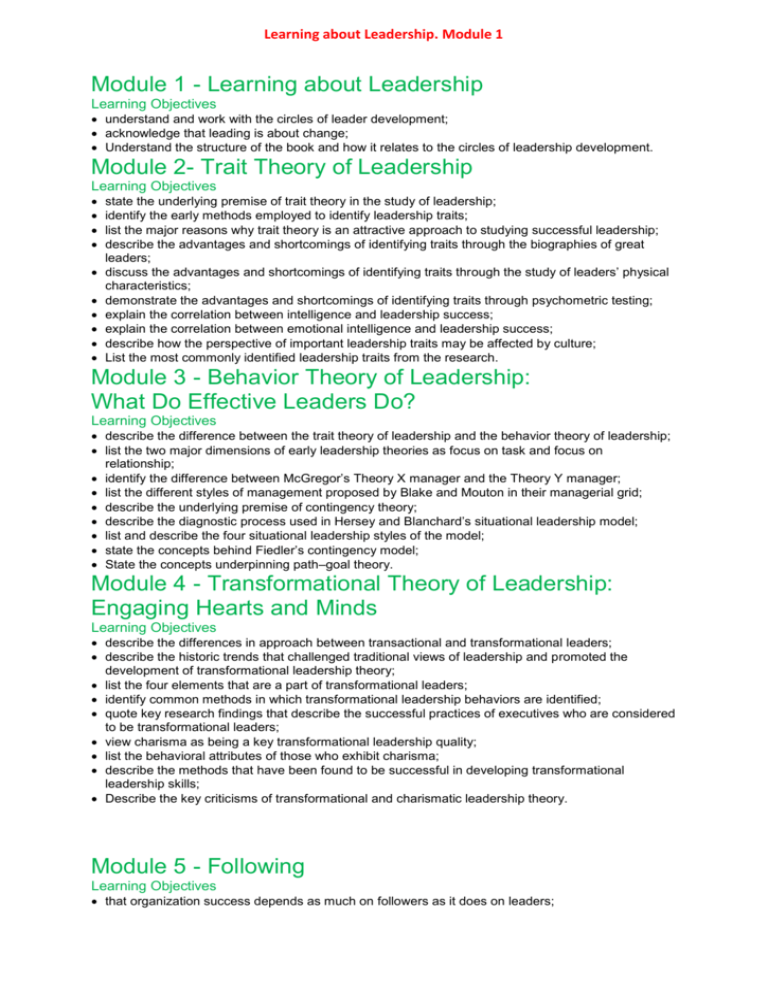
Learning about Leadership. Module 1 Module 1 - Learning about Leadership Learning Objectives understand and work with the circles of leader development; acknowledge that leading is about change; Understand the structure of the book and how it relates to the circles of leadership development. Module 2- Trait Theory of Leadership Learning Objectives state the underlying premise of trait theory in the study of leadership; identify the early methods employed to identify leadership traits; list the major reasons why trait theory is an attractive approach to studying successful leadership; describe the advantages and shortcomings of identifying traits through the biographies of great leaders; discuss the advantages and shortcomings of identifying traits through the study of leaders’ physical characteristics; demonstrate the advantages and shortcomings of identifying traits through psychometric testing; explain the correlation between intelligence and leadership success; explain the correlation between emotional intelligence and leadership success; describe how the perspective of important leadership traits may be affected by culture; List the most commonly identified leadership traits from the research. Module 3 - Behavior Theory of Leadership: What Do Effective Leaders Do? Learning Objectives describe the difference between the trait theory of leadership and the behavior theory of leadership; list the two major dimensions of early leadership theories as focus on task and focus on relationship; identify the difference between McGregor’s Theory X manager and the Theory Y manager; list the different styles of management proposed by Blake and Mouton in their managerial grid; describe the underlying premise of contingency theory; describe the diagnostic process used in Hersey and Blanchard’s situational leadership model; list and describe the four situational leadership styles of the model; state the concepts behind Fiedler’s contingency model; State the concepts underpinning path–goal theory. Module 4 - Transformational Theory of Leadership: Engaging Hearts and Minds Learning Objectives describe the differences in approach between transactional and transformational leaders; describe the historic trends that challenged traditional views of leadership and promoted the development of transformational leadership theory; list the four elements that are a part of transformational leaders; identify common methods in which transformational leadership behaviors are identified; quote key research findings that describe the successful practices of executives who are considered to be transformational leaders; view charisma as being a key transformational leadership quality; list the behavioral attributes of those who exhibit charisma; describe the methods that have been found to be successful in developing transformational leadership skills; Describe the key criticisms of transformational and charismatic leadership theory. Module 5 - Following Learning Objectives that organization success depends as much on followers as it does on leaders; that leaders’ and followers’ preferences may collide; the kinds of followers; leaders and followers as relationships; regressive relations, symbolic relations and developmental relations; how followers shape leaders; The significance of emotions, distributed leadership, critical reflections, cultural context, antifollowers and antileaders in leader–follower relations. Module 6 - Leadership: A Cultural Construction? Learning Objectives acknowledge the complexity of the constructs of culture; consider the idea of culture of organizations; understand linkages of leadership and national culture; consider the linkage of leadership and organizational culture; understand whether leaders can affect organizational culture; Consider leadership in different sectors: private; public and voluntary. Module 7 - Gender and Leadership Learning Objectives the recent presence and the prior marked absence of female voices in organizational leadership; the research debates and findings on how men and women leaders are necessarily different; how these research debates and findings relate to leadership theories; how women cope with male organizations; that organizational demographics might explain gender similarities; The pursuit of wisdom in leadership. Module 8 - Developing Ethical Behavior in Our Leaders Learning Objectives define the term ‘ethics’ in relationship to a leadership context; differentiate between ethical behavior and legal behavior; describe an ethical dilemma; identify a number of ethical dilemmas that typically confront today’s organizations; decide how ethics should impact on the profit motive in organizations; understand the role of ethical statements, values statements, whistleblower policy and leadership in supporting ethical behavior; define the difference between negative, congruent and positive ethical gaps in organizational philosophies; describe the difference between ethical road maps based on principles, on outcomes and on moral virtues; Describe how ethical behaviors impact on effective leadership. Module 9 - Leading Individuals and Teams: Two Distinct Roles Learning Objectives identify the different leadership concerns in leading an individual, in leading a team, and in providing leadership across a larger organization; describe the components of the underpinning leadership behaviors involved in self leadership and transcendent leadership; differentiate task oriented leadership behaviors from people oriented behaviors; identify the developmental level of employees for specific tasks based on the situational leadership model; choose the appropriate leadership style to match the follower’s development level; describe behaviors included in each of the four leadership styles: directing, coaching, supporting and delegating; state the advantages and disadvantages of overleading and underleading; list Tuckman’s four team development stages; choose the appropriate leadership behaviors required to address each team development stage; Describe the relationship between team development stages and the employee developmental levels of situational leadership. Module 10 - Leadership across the Larger Organization Learning Objectives describe the situations in which organizational leadership skills are required; identify the differences between organizational leadership and leadership of individuals or teams; list the five sources of social power and give examples of each; describe a scenario in which a combination of social powers would be appropriate; define the difference between power and influence; list the five leadership practices identified by Kouzes and Posner and several leadership activities that would support each practice; Identify areas in your leadership role where you can make better use of social power and influencing skills. Module 11 - Leadership Development in a Fast- Changing World Learning Objectives • identify the reasons why leadership development continues to be of great concern to most organizations; • state how the focus of leadership development is moving away from developing individual leaders; • list the six contextual changes that impact on the evolving approach to leadership development; • describe the implication of stratified systems theory for leadership development; • describe the implication of the theory of learning organizations for leadership development; • explain why leadership is moving from the individual to teams; • define a framework for developing the leadership function; • list at least five components of the framework. Module 12 - The Development of Leadership: Tools and Practices Learning Objectives make a judgment as to how much leadership ability can be influenced through a developmental process; describe the behavioral choice model of leadership; describe the main tenets of each of the six theories of learning presented in the module; state the role of hiring external people in the development of the leadership function; describe the role of universities in providing developmental support for organizational leadership; state several methods of leadership development by job assignment; state several methods of leadership development by assessment and feedback; state several methods of leadership development by one-to-one support; state several methods of leadership development by structured learning programs; Develop a view on the effectiveness of the leadership development processes available in your organization. Module 13 - Strategic Leadership Learning Objectives that three different strategy eras have shaped ideas of strategic leadership; the roles of the strategic leader – configuring, facilitating, delivering and evaluating (learning) and changing; the idea of strategic alignment and how to work with it; That the origins of strategic leaders are embedded in the three strategic eras. Module 14 - Leadership and Risk Learning Objectives the ubiquity of risk and uncertainty; how risk is handled privately, publicly, individually and collectively; how risk stances shape the leadership of corporate risk management; organizational risk management purposes and consequences; socially and culturally shaped perceptions of risk; Organizational leadership in a risk society. Module 15 - How Is Leadership Studied? Learning Objectives the ontological and methodological framing of leadership research; where different theories of leadership are located in this frame; how to conduct research in leadership in field studies, and case studies in both positivist and constructionist frames; the challenge of doing fieldwork in leadership research; the researcher skills needed in leadership research and consider ethical issues in leadership research; The differences and consequences of different framings of leadership studies. Module 16 - A Critical Look at Leadership Learning Objectives the ideological contexts of leadership theory; national and transnational ideological leadership issues; the idea of leaders as agents of others in the corporation; three critiques of functional leadership: service, institutionalization and privilege; how the critiques move from a functional stance to a social constructionist stance; Three models of leader formation: an innate quality, innate qualities assisted by action reflection and theory building (which is where this course lies), and design and build. Module 17 - The Way Forward: Our Learning and the Application of Our Knowledge of Leadership Learning Objectives list the themes that were meaningful to you through the course of this study of leadership; describe systems by which organizations learn; describe how those systems can be employed to develop the leadership function within your own organization; list the five steps involved in managing your own leadership development process; Combine each of those steps into a leadership development plan that can be used to develop your own leadership effectiveness. Learning Objectives • understand and work with the circles of leader development; • acknowledge that leading is about change; • understand the structure of the book and how it relates to the circles of leadership development. The outer circle is based upon acknowledging your experience of leadership in organizations, reflecting upon that experience, examining those experiences and reflections against the theories of leadership and then planning how you might plan to change your own leadership and leadership in your organization. The inner circle is about you. Beginning with your personal experience of being a leader, reflecting upon that experience, examining those reflections against theories of persons as leaders, and then planning to change and develop yourself as a leader. Warren Bennis, a noted writer on leadership, borrowed William Shakespeare’s idea of the seven stages of a man’s life to consider the parallel stages of a leader’s development. Three types of leadership - First came traditional, by which he meant that the leader’s authority came from social, political and institutional continuity. Examples are kings, tribal leaders, religious leaders and such. Second was rational legal, where the leader’s authority came from constitutions of nations and organizations. Examples are presidents, prime ministers, trade union officers etc. Third was charismatic, where the leader’s authority came from inside the person and was accepted by those who were inspired to follow. • Accidental leadership will not be focused upon any dynamic of change but may, like a stopped clock, find a correct solution with the passage of time. • Preservative leadership will seek to keep the traditions and business practices intact, perhaps with considerable attention to both the effectiveness of those practices and the efficiency of the business processes. • Enabling leadership will work to allow others, probably more junior but not necessarily so, to use their own leadership in their work. • Strategic leadership will be concerned with purposes and their achievement in the evolving context in which the business seeks to operate. The normative culture is where all thought and action is infused with attention to and debates about values, and people belong because they subscribe to the values. The instrumental cultures are those where people belong because they can get something they want and are prepared to compromise in order to get it; business organizations have much of this characteristic. Coercive organizations require and force people to belong: prisons and armies are such. Top leaders, it appears, tend to be very careful to listen to a range of views and relatively slow to come to a view. It seems that judgment is more important for them as it forms the context within which decisions can be made. Here we get a glimpse of the difference between policy and strategy. Policy is of the whole society, of the whole community, and shapes the values, beliefs and assumptions of the organization.
